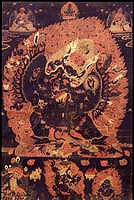
|
Tutelary Deity Yamantaka (painting no. 198)
|

View Larger Image |
||||||||||||||
|
Vajra Bhairava Ekavira (The Solitary Hero Vajra Terror) a wrathful form of Manjushri. The ferocious Vajra Bhairava is black in colour with 9 faces, 32 hands and 16 legs. The main face is that of a buffalo, with a red face above and the slightly angry yellow face of Manjushri placed on top. Flames entwine the two horns and shoot fire from the tips. The three right faces, stacked one above the other, are blue, red and yellow and the three left are white, smoky coloured and black. Each face has three large round eyes, bared fangs and each conveys a different emotional expression; yellow hair flows upward like rising flames. The first pair of hands hold a curved knife and skullcup at the heart. The remaining hands hold a multitude of weapons with the last set also holding the fresh outstretched hide of an elephant. Each face is adorned with a crown of five skulls and bone earrings. He wears a snake necklace and a garland of fifty heads. The right legs are bent pressing down on a variety of creatures and gods. The left legs are extended straight and press upon eight birds and various gods. Above a sun disc and multi-coloured lotus blossom he stands in the middle of a mass of orange flames of pristine awareness. Placed at the front of the lotus is a skullcup containing a red triangular offering ‘torma’ (stylized food) and slightly below to each side are two more skullcups filled with various offerings. At the top center is Vajradhara, the primordial buddha, dark blue in colour, with one face and two hands holding a vajra and bell to the heart. At the left corner is a lama wearing monastic robes and a red cap performing the mudra (gesture) of blessing with the right hand and holding a Dharma wheel in the lap. At the right corner is a Lama wearing monastic robes and a red pandita hat performing the mudra (gesture) of blessing with the right hand and holding a gold object in the left. The names of the two lamas are written in very small fine gold lettering beneath each. At the bottom center is the special protector for the Vajra Bhairava cycle of practice, Yama Dharmaraja, black, with one face and two hands holding a stick and noose embraced by the consort Chamundi and mounted atop a buffalo; surrounded by flames. To the left is the guardian of the northern direction, yellow Vaisravana, holding a banner and mongoose riding atop a snow lion. To the right is Panjarnatha Mahakala, protector for the Hevajra Tantras, black, with one face and two hands holding a curved knife and skullcup with a stick across the forearms; surrounded by flames of pristine awareness issuing forth animal and bird messengers amongst the licks of flame. As a tutelary deity Vajra Bhairava, also known as Yamantaka, belongs to the Bhairava and Yamari class of tantras and specifically arises from the Vajra Bhairava Root Tantra (Tibetan: Jig je tsa gyu). All of those belong to the method (father) classification of Anuttaryoga Tantra. The practice of Bhairava is common to the three Sarma Schools: Sakya, Kagyu and Gelugpa. Among the Sakya it is counted as one of the four main tantric deities along with Hevajra, Guhyasamaja and Chakrasamvara (Tibetan: gyu de shi). Amongst the various Kagyu Schools the Drikungpa have been strong upholders of the practice. There are numerous forms and styles of practice from the very complex with numerous deities to the very concise with a single Heruka form. From the many lineages to enter Tibet the main ones were those of Jowo Atisha, Rwa Lotsawa, Mal Lotsawa and the like. Mal Lineage: the lord of Refuge Vajradhara, Arya Manjushri, Acharya Buddha Jnana, Dipamkara Zangpo, Brahmin Shridhara, the pandita and mahasiddha Naropa, Minyam Dorje Khol, the Nepali of Yerang Bharo Chagdum, Mal Lotsawa Lodro Dragpa, Sachen Kunga Nyingpo (1092-1158), etc. The style of painting is ‘black scroll’ (Tib.: nag thang) - gold outline on a black background with various colours used for detailing the figures. This style is reserved for wrathful figures. J.Watt 7-98
|
|||||||||||||||
Photographed Image Copyright © 1998 Shelley & Donald Rubin Foundation
|
|
| |
Next Image |